For the 2025 school year, there are 2 public elementary schools serving 301 students in Kingsley-Pierson Comm School District. This district's average elementary testing ranking is 4/10, which is in the bottom 50% of public elementary schools in Iowa.
Public Elementary Schools in Kingsley-Pierson Comm School District have an average math proficiency score of 62% (versus the Iowa public elementary school average of 66%), and reading proficiency score of 72% (versus the 69% statewide average).
Minority enrollment is 13% of the student body (majority Hispanic), which is less than the Iowa public elementary school average of 29% (majority Hispanic).
Overview
This School District
This State (IA)
# Schools
3 Schools
924 Schools
# Students
438 Students
320,020 Students
# Teachers
32 Teachers
23,100 Teachers
Student : Teacher Ratio
14:1
14:1
District Rank
Kingsley-Pierson Comm School District, which is ranked within the top 50% of all 325 school districts in Iowa (based off of combined math and reading proficiency testing data) for the 2021-2022 school year.
The school district's graduation rate of 80% has decreased from 90% over five school years.
Overall District Rank
#137 out of 327 school districts
(Top 50%)
(Top 50%)
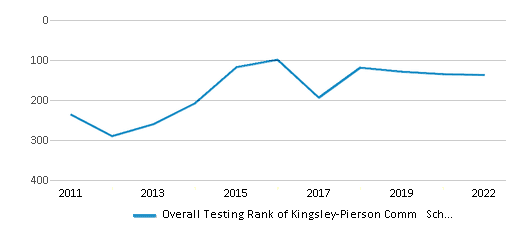
Math Test Scores (% Proficient)
65%
64%
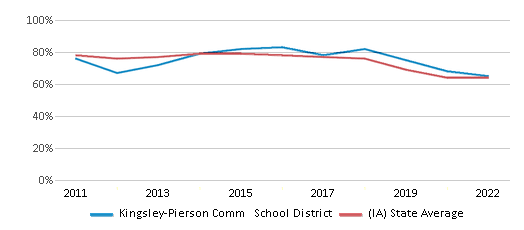
Reading/Language Arts Test Scores (% Proficient)
78%
70%

Science Test Scores (% Proficient)
65-69%
63%

Graduation Rate
≥80%
90%
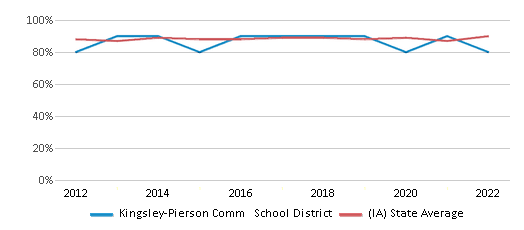
Students by Ethnicity:
Diversity Score
0.23
0.47
# American Indian Students
2 Students
1,327 Students
% American Indian Students
1%
n/a
# Asian Students
2 Students
7,817 Students
% Asian Students
1%
3%
# Hispanic Students
37 Students
40,728 Students
% Hispanic Students
8%
13%
# Black Students
1 Student
22,463 Students
% Black Students
n/a
7%
# White Students
383 Students
228,520 Students
% White Students
87%
71%
# Hawaiian Students
4 Students
2,308 Students
% Hawaiian Students
1%
1%
# Two or more races Students
9 Students
16,789 Students
% of Two or more races Students
2%
5%
Students by Grade:
# Students in PK Grade:
-
17,527
# Students in K Grade:
29
35,055
# Students in 1st Grade:
31
34,545
# Students in 2nd Grade:
31
35,477
# Students in 3rd Grade:
48
35,334
# Students in 4th Grade:
29
35,902
# Students in 5th Grade:
26
35,813
# Students in 6th Grade:
33
35,551
# Students in 7th Grade:
32
24,719
# Students in 8th Grade:
42
22,978
# Students in 9th Grade:
32
1,729
# Students in 10th Grade:
44
1,838
# Students in 11th Grade:
32
1,809
# Students in 12th Grade:
29
1,743
# Ungraded Students:
-
-
District Revenue and Spending
The revenue/student of $16,221 in this school district is less than the state median of $16,468. The school district revenue/student has stayed relatively flat over four school years.
The school district's spending/student of $23,886 is higher than the state median of $16,042. The school district spending/student has stayed relatively flat over four school years.
Total Revenue
$7 MM
$8,262 MM
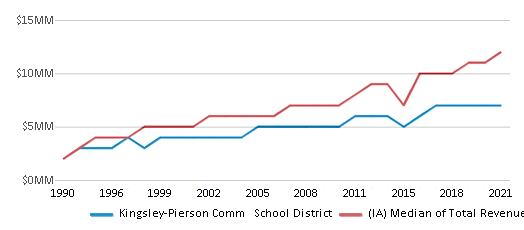
Spending
$11 MM
$8,048 MM
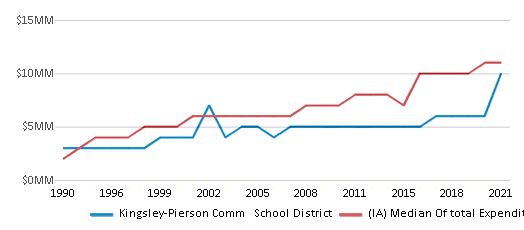
Revenue / Student
$16,221
$16,468
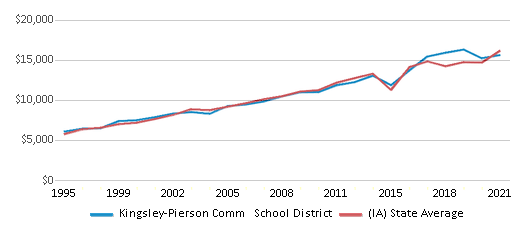
Spending / Student
$23,886
$16,042
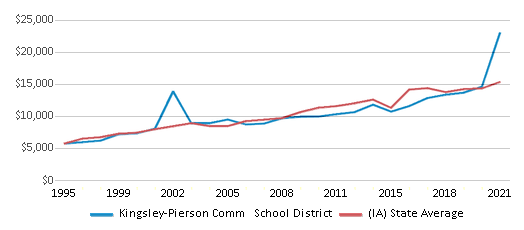
Best Kingsley-Pierson Comm School District Public Elementary Schools (2025)
School
(Math and Reading Proficiency)
(Math and Reading Proficiency)
Location
Grades
Students
Rank: #1 - 21. - 2.
Kingsley Elementary School
(Math: 60-64% | Reading: 70-74%)
Rank:
Rank:
5/
Bottom 50%10
322 Quest Avenue
Kingsley, IA 51028
(712) 378-2861
Kingsley, IA 51028
(712) 378-2861
Grades: K-4
| 168 students
Rank: #1 - 21. - 2.
Pierson Middle School
(Math: 60-64% | Reading: 70-74%)
Rank:
Rank:
5/
Bottom 50%10
321 4th St
Pierson, IA 51048
(712) 375-5939
Pierson, IA 51048
(712) 375-5939
Grades: 5-8
| 133 students
Recent Articles

Year-Round Or Traditional Schedule?
Which is more appropriate for your child? A year-round attendance schedule or traditional schedule? We look at the pros and cons.

Why You Should Encourage Your Child to Join a Sports Team
Participating in team sports has a great many benefits for children, there is no doubt. In this article you will learn what those benefits are.

White Students are Now the Minority in U.S. Public Schools
Increasing birth rates among immigrant families from Asia and Central and South America, combined with lower birth rates among white families, means that for the first time in history, public school students in the United States are majority-minority. This shift in demographics poses difficulties for schools as they work to accommodate children of varying language abilities and socio-economic backgrounds.





